Best Practices in eCommerce Returns Management: Navigating the Aftermath of Holiday Shopping
 Fulfil
Fulfil
Efficiently navigate returns in eCommerce with our guide on Best Practices in Returns Management. Uncover red flags, implement strategies to minimize returns, and discover how leading brands leverage data, technology, and clear processes.
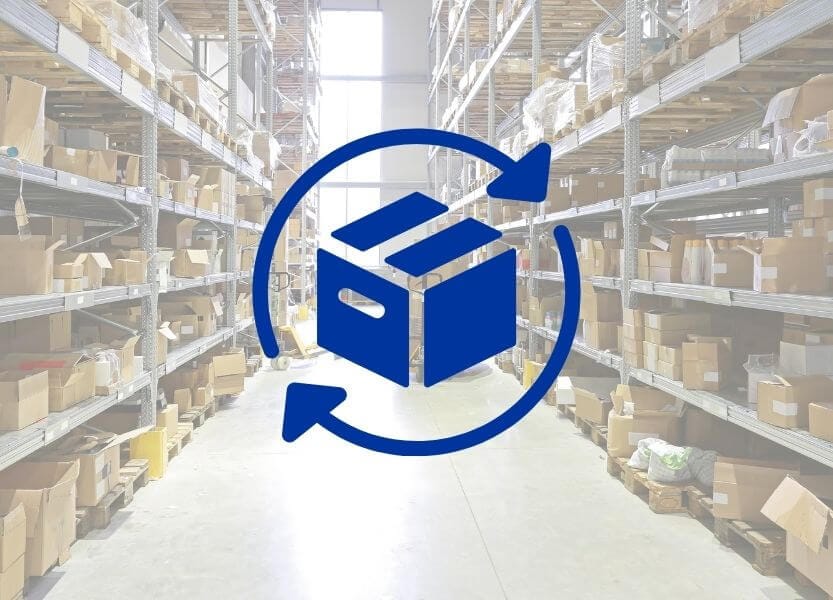
As the dust settles on the frenzy of Black Friday and Cyber Monday (BFCM) and the last-minute holiday purchases are made, another battle for merchants emerges on the horizon: returns. But with the right processes, technology, and strategies in place, you can make this inevitable part of business more efficient and a whole lot better for your bottom line.
Here’s a quick snapshot of what we’ll cover:
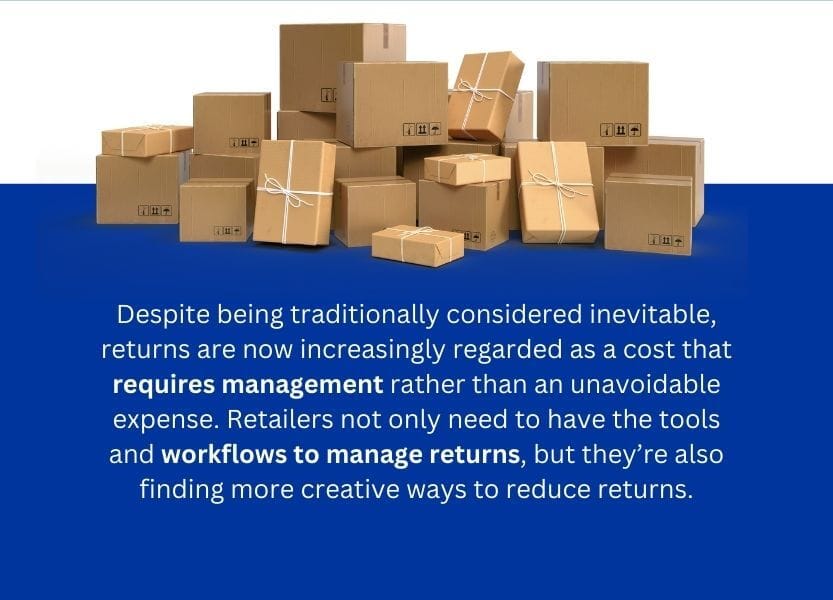
The “Red Flags” of eCommerce Returns: Do you have a returns management problem?
Holiday returns in the United States are estimated to exceed $300 billion annually, which is approximately 1.5% of the U.S. GDP. This figure is higher than the GDP of many countries. This key takeaway from the 2023 Reverse Logistics Association Conference highlights the sheer scale of this growing problem and the significant economic impact of post-Christmas returns.
Recognizing these red flags in your business can be the first step toward addressing and mitigating the impacts of inefficient returns management.
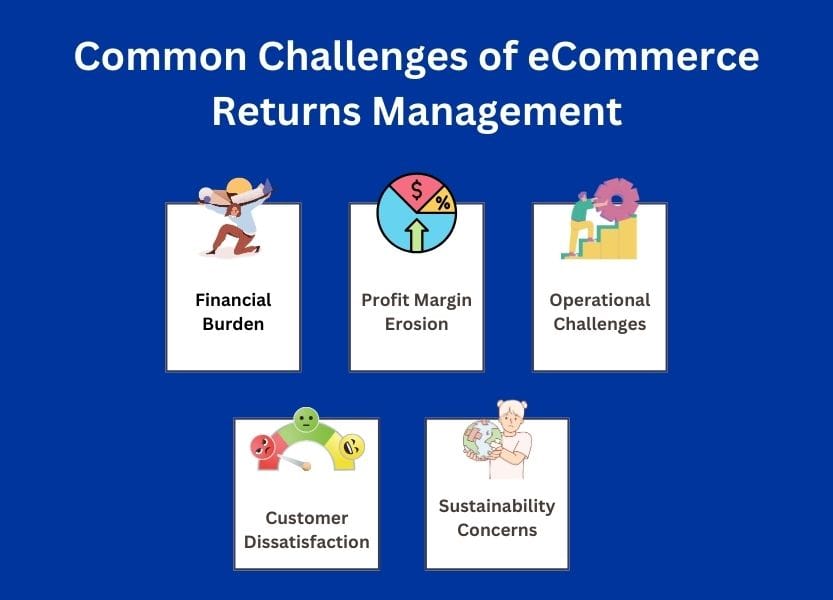
Ask yourself if you're facing these common challenges of eCommerce returns management:
Financial Burden:
- Are you experiencing significant costs associated with processing returns?
- Do handling, shipping, warehousing, and inventory management costs strain your budget?
- Are you losing sale value due to returned items?
Profit Margin Erosion:
- Do you find a substantial part of your profit margins diminishing due to high return rates?
- Are you forced to mark down or liquidate returned items, impacting profitability?
Operational Challenges:
- Is managing the high volume of returns overwhelming your logistics and operational systems?
- Do you find the task of handling, inspecting, refurbishing, or disposing of returned items complex and time-consuming?
Customer Experience and Loyalty:
- Are you struggling to maintain customer satisfaction due to return process inefficiencies?
- Is your return process potentially driving away customers and hurting future business?
Sustainability Concerns:
- Do the environmental impacts of returns, such as waste generation and carbon footprint, concern you?
- Are you under pressure to adopt more sustainable return management practices?
Here’s the silver lining: a higher volume of returns provides an opportunity for retailers to gather data and insights. As the National Retail Federation (NRF), puts it, it’s time to shift your mindset on how you view and manage returns.
Instead of seeing them merely as a cost or loss, consider returns as an opportunity to enhance your customer service, gather insights for product improvement, and implement strategic measures to minimize return rates.
While there’s no way to eliminate returns, there are ways to minimize them.
This approach reflects a broader trend in the retail industry, where effective returns management is increasingly recognized as a crucial element of overall business strategy and customer satisfaction.
Best Practices For Managing eCommerce Returns
While return management processes typically depend on the merchant and operations, here are some best practices to keep in mind.
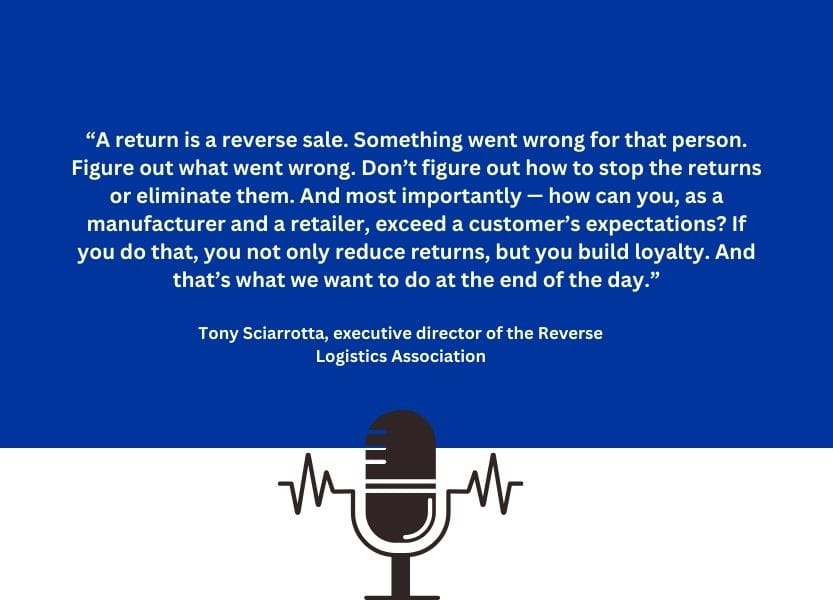
Before diving into these best practices, let’s consider a perspective from Tony Sciarrotta in a 'Retail Gets Real' episode by the National Retail Federation. He suggests viewing a return as a 'reverse sale,' which reframes the issue from mere transactional logistics to understanding and fixing what didn't work for the customer.
When you think of returns in this way, the focus shifts to why the return happened. This approach allows you to collect valuable insights about customer needs and what might be lacking. It becomes a powerful tool for understanding customer dissatisfaction and guiding improvements in products and services. More than just understanding, it’s about taking action based on this knowledge.
Utilizing Returns Data
Investigate the status of your products and their return rate. With these insights, you can use them to inform product design and make better decisions for inventory levels, production, and assortment planning.
Mytheresa is a luxury retailer that uses detailed data to reduce return rates and improve inventory decisions. In 2016, Mytheresa launched a dedicated team to measure every garment before it's listed online, including specific measurements like chest, waist, and hips. This data is used to create detailed size guides, aiming to reduce returns due to size issues.
Mytheresa also uses a machine-learning algorithm developed by its in-house data scientists. This algorithm, launched in 2021, analyzes customer behaviors and 20 different variables to identify potential high-spending customers who are likely to make repeat purchases and are more familiar with their sizes in specific brands. This approach helps Mytheresa cater to customers less likely to return items, thereby reducing returns and allowing for more precise inventory decisions.
Leveraging Technology
Technology can give you a significant upper hand when it comes to improving the shopping experience, all whilst helping your customers make more informed purchase decisions.
- AI-driven recommendation systems can personalize shopping by suggesting products aligned with customers' preferences and past purchases.
- Augmented reality (AR) tools allow for virtual try-ons or enable customers to visualize products in their own space.
- Comprehensive product information, alongside customer reviews and Q&A sections on product pages, provides in-depth insights into products.
- Chatbots and virtual assistants can be employed to offer tailored shopping advice and support, making the online shopping experience more interactive and personalized.
Establishing Clear Ownership
To establish clear ownership for managing returns in a business, designate a team or individual responsible for overseeing the returns process. This includes monitoring return rates, analyzing reasons for returns, and implementing strategies to reduce return rates. This team should also work closely with customer service, logistics, and inventory management to ensure a smooth and efficient process.
Optimizing Logistics from a Warehouse POV
Optimizing logistics in a warehouse involves streamlining the process of handling returned items, reducing costs, and increasing the speed of processing returns.
For example, Mercado Libre has implemented measures to improve the restocking of returned items. Notably, in the third quarter of 2023, the company successfully restocked 81% of the returned apparel goods it received, a significant improvement from 54% in the previous year. Here’s what they did:
- Improved Repackaging Processes: Mercado Libre introduced repackaging tools in its warehouses, ensuring items like sneakers retain resale value and efficiency in restocking.
- Increased Drop-Off Locations: The company expanded return drop-off points by 10% to 7,000 locations, streamlining the return process and speeding up item restocking.
- Centralized Fulfillment Centers: With 21 centers globally, Mercado Libre efficiently processes and restocks returned items, leveraging centralized handling.
💡 Optimize customer interactions seamlessly across all channels with a centralized Order Management System (OMS) embedded in an Enterprise Resource Planning (ERP) platform like Fulfil. This integration ensures accurate customer tracking across various platforms and delivers a consistent customer experience across different channels. Discover more about improving your multichannel customer experiences.
Efficient Return Process
Develop a system to quickly handle customer returns, ensuring a smooth and hassle-free experience. This can involve automated return requests and rapid processing of refunds or exchanges.
💡 Process all orders, returns, and inventory data in one place using Fulfil's order management capabilities for a real-time comprehensive view of all sales, returns, and inventory levels. You can also use Fulfil’s return API to create your own RMA (Return Merchandise Authorization) regardless of which platform you use.
Monos, a Vancouver-based luggage company, has implemented a distinctive approach to managing returns since its 2019 launch. Unlike competitors like Away, Monos charges a $40 return fee, a strategic decision that aligns with its goal of maintaining lower operating expenses. This fee covers all costs associated with the return, including shipping and warehouse labor for inspection and restocking, and it also offers the convenience of at-home pick-up for customers in the US and Canada.
The company's approach is not just about managing costs but also about enhancing customer experience and loyalty. More than half of the returns Monos receives are in unused and resalable condition, which minimizes losses from damaged returns.
The return fee acts as a deterrent against impulse buying, resulting in a lower return rate of about 5%, compared to the industry average of 8-10%.
Monos' strategy also includes offering store credits during the returns process, and encouraging customers to make additional purchases. This approach not only retains customers but also drives sales growth. By focusing on attracting quality customers with intent, Monos has successfully maintained a high gross profit margin above 70% since its inception.
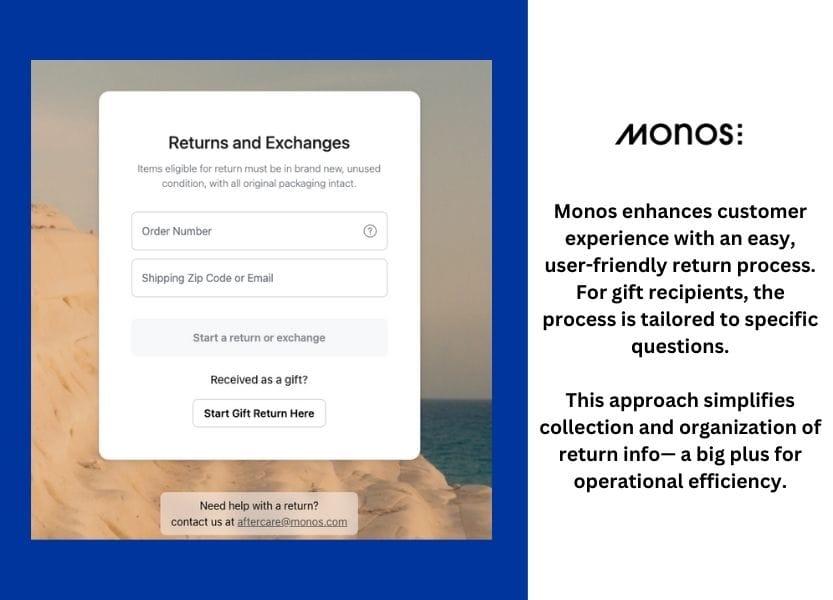
Inventory Management in Returns
Implement a robust system for handling returned inventory. This could include real-time tracking of returned items, efficient restocking processes, or proper disposal methods for unsellable goods.
💡 Fulfil natively supports Shopify Returns API for merchants: Our integration gives you improved visibility into your inventory expected from returns and empowers them with the capability to efficiently manage returns directly within Fulfil. Keeping their financials and inventory stock up to date in real-time.
Customer Relationship Management
Find ways to maintain strong relationships with customers throughout the return process. This includes providing clear communication on the status of returns, addressing customer queries promptly, and using feedback from returns to improve customer service strategies.
💡 Fulfil gives real-time information, so that your customer support team can then quickly share and update the client with the status of the return.
Now that you have some insight into managing the process once a return has occurred, let’s look at more proactive measures to reduce the frequency of returns.
How to Reduce Returns in eCommerce
The most effective way to manage the high cost of returns is to reduce the number of returns in the first place.
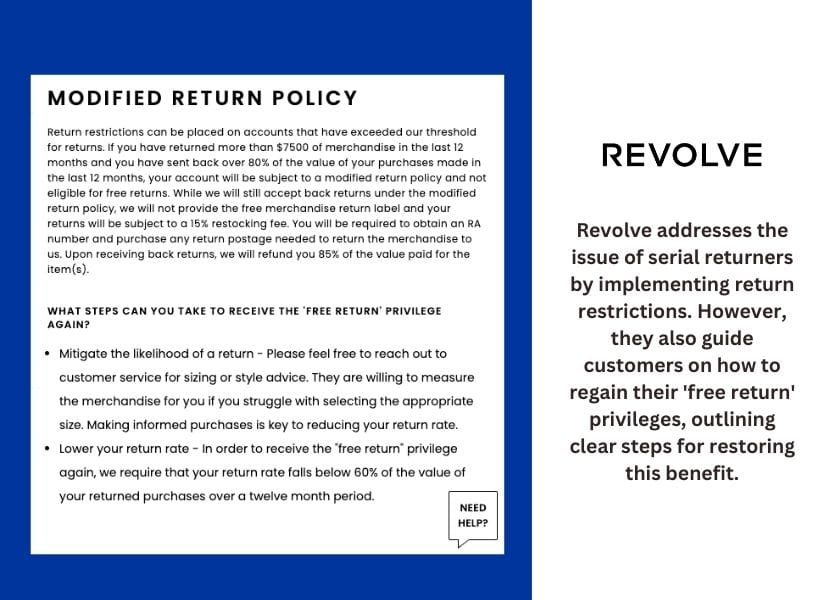
- Encourage Exchanges or Store Credit: Before processing returns, offer customers the option to exchange items or receive store credit. This can retain sales and reduce the number of returns.
- Target Serial Returners: Implement measures to identify and block serious offenders of return policies. This can include tracking return patterns and limiting returns for these customers. For example, Revolve has a specific return restriction for customers who have exceeded their threshold for returns.
- Restocking Fees: Apply restocking fees for high-value returns, such as orders over $500. This practice can discourage binge shopping and excessive returns.
- Return Policy Transparency: Ensure the return policy is clear and approved at checkout, especially for high-end brands or specific categories like home goods. Implement approval processes for returns over a certain value to distinguish between one-time and loyal customers.
- Charge for Return Shipping: Consider charging a nominal fee for return shipping, as free returns can increase the volume of returns.
- Improve Product Fit and Sizing: Undertake projects to standardize product sizing across all lines. This involves redeveloping products for consistent sizing, updating size guides, and using customer feedback to create a standard fit avatar. This isn’t a quick fix, but it’s something that will set you up for success in the long run.
- Detailed Return Reasons: Refine the return process to gather more specific feedback. Instead of broad categories like “changed my mind,” include options related to quality, price, fabric, fit, style, color, etc.
- Customer Surveys and Interviews: Conduct surveys and interviews with customers, especially those who have returned items, to understand their concerns and improve product offerings.
- Enhanced Customer Support: Train customer support staff to be knowledgeable about sizing to assist customers before purchasing.
- Use of User-Generated Content (UGC): Display customer and influencer photos of various sizes on product detail pages (PDP) to give a realistic view of how products fit or look.
- Final Sale Items: For items you don't want returned, mark them as final sale and make this clear on FAQs, product pages, order confirmations, and other relevant places.
- Customizable Fit Solutions: Offer innovative solutions to adjust the fit of products, as seen in Bared Footwear's approach. This includes providing fit kits with forefoot padding, gel spots, and heel inserts to allow customers to tailor the fit of their shoes. This proactive measure addresses fit issues before they lead to returns.

Final Thoughts: Turning Returns into Opportunities for Growth
Post Black Friday, Cyber Monday, and the holiday season, every eCommerce business faces the reality of returns. This period isn't just about efficient return management; it's an opportunity for business growth and improvement.
Viewing returns as 'reverse sales' changes perspective, focusing on understanding and addressing the customer's needs. Each return is a chance to uncover the 'why,' providing insights for enhancing products and services.
Acting on these insights is crucial. For example, if sizing issues are a common reason for returns, it’s a hint to reassess your sizing guidelines or product designs. This proactive step not only refines your offerings but also boosts customer experience and loyalty.
While completely eliminating returns isn't possible, adopting effective strategies can significantly reduce them. By doing so, you transform the challenge of returns management into a chance for optimization, enhancing customer relationships, and driving strategic growth.
Tags:

Fulfil
Fulfil is the AI-native ERP built for modern Shopify and DTC brands. No consultants. No middleware. No surprises. Connect your sales channels, warehouses, accounting, and fulfillment in one system. Set up in weeks, not months.